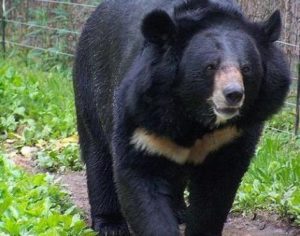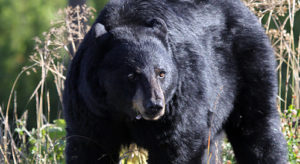
Asiatic black bear
Dear Mr. or Ms. Evolutionary Biologist,
Thank you in advance for your time, of which I hope not to waste too much. If you happen to be an ursinologist, your assistance will be especially welcome.
Before I start, I think it it is only fair that you know the audience. I should properly identify myself as a Christian, so that you will be aware of the possibility my confirmation bias (which I believe everyone has) could unduly affect my interpretation of published scientific evidence. I also believe in supernatural creation, because I am well aware that life cannot evolve until it exists.
However, I typically describe myself as theist-agnostic. By that, I simply mean that I believe in the Judeo-Christian supernatural creator God called Yahweh, and I also believe that Jesus was the promised, crucified, and resurrected Messiah. That’s the “theist” part of the descriptor. On the other hand, I also realize that I actually don’t know very much when it comes to answering the existential questions. That’s the reason for the “agnostic” qualifier…I can’t even claim that my beliefs constitute knowledge, because sometimes beliefs turn out to be wrong. Pleading agnosticism is admitting to ignorance. My desire to become less ignorant is the reason for writing you this letter.
So without further ado, please allow me to get right to the crux of what I want to know: what special characteristics of any two species of bears makes it necessary for them to be classified as more than one species? After all, there are five billion or so humans on earth, all properly classified as homo sapiens. What makes bears more special than human beings?
Yesterday morning, in an internet forum I pointed out there are allegedly eight unique species of bears, but only one species of human beings with approximately five billion members, and asked an evolutionary biologist there for an explanation for the definition of species. I asked him to help me understand how the origin of a new species could be determined, and I mentioned that it seemed an inconsistent methodology and use of vague terms by colleagues in his particular field of expertise tended to cause some confusion.
Rather than simply answering my question, this evolutionary biologist ridiculed me for my interest. In a condescending tone he insisted that I had been given this information in the past and told that I should “learn something” for a change. That last suggestion struck me as excellent advice, and I took it.
So thanks for the inspiration, Herman.
First, I confirmed that according to biological classification, there are allegedly eight unique species of bears. Two of these eight unique species are Asiatic black bears and North American black bears. So my question becomes very simple. How, exactly, are Asiatic black bears different from their North American cousins?
According to this website, the Asiatic black bear has slightly longer and softer fur. Yet the most significant difference for the purposes of unique identification is a colored swath of fur on the chest of the Asiatic black bear:
The most obvious difference between the two species is the chest blaze.
Is that it? Seriously? That’s the best, most important reason for identifying these animals as two unique species? A colored patch of chest fur?
Both of these varieties of black bears are excellent tree climbers and prefer a diet that includes plants, fruits, berries, and bees’ nests. Furthermore, the website also claimed that as many as one of every four North American black bears may have the same chest blaze as their Asiatic cousins. In other words, there is a 25 percent chance that a North American black bear might have the same chest blaze. Trying to apply logic here for a moment, if a North American black bear with a chest blaze managed to somehow migrate to Asia, could it be easily distinguished from the native bear species? If so, how? If not, why are Asiatic black bears and North American black bears being classified as two different species?
For the purpose of comparison, also please consider the physical differences between a typical Japanese human and a white European human. Hair color, eye color, and skin color should allow the native Japanese person and a typical white European to be easily differentiated — a person with natural blond hair and blue eyes tends to stand out in a crowded Tokyo bar, but not so much in London.
By the same token, we know that Japanese humans and white European humans can successfully mate and produce fertile offspring. According to any reasonable biological criteria, Japanese people and white Europeans are clearly members of one species, because by sexual reproduction they may participate in the continuation of the species. In fact, it would be silly, and perhaps even racist, to suggest otherwise.
Therefore, I’d like to propose a scientific experiment. Since I’m not an actual scientist and don’t do this sort of thing, I’ll just toss out the idea for public consumption– what about an experiment where a small breeding population of Asiatic black bears might be integrated into a small community of North American black bears? The purpose would be to see if these two allegedly unique species of bears are only classified separate species because they have been physically kept separated, and mating becomes geographically impossible. If the sows fail to conceive, suffers miscarriage, or the offspring is sterile, then we can probably say with some degree of certainty that Asiatic black bears and North American black bears are truly separate and distinct species of bear. Perhaps the Asiatic black bear just has a bummer of a birthmark. (Apologies to Gary Larson of “The Far Side” fame.)
Or is there another reason there are two “species” of black bear? Please tell me that there is something a little more obvious to help the layman understand the difference between the Asiatic and North American varieties of black bear than the interphotoreceptor retinoid binding protein, because then you’re going to have to explain exactly what that means, and its impact on the distinction between two individual species.
We also know bear species that are not as closely related as the two species of black bears have nevertheless successfully produced live offspring — the hybrid descendants of grizzly and polar bears have been encountered in the wild. The only question that remains is whether or not the offspring will be fertile, which means that it becomes part of the breeding population. We should naturally expect the results of our little “experiment” to be viable offspring, because it already happens in the wild. A simple fertility test could finally settle the question of whether or not black bears should be considered more than one species, or if any bear (except the marsupial koala bear) should be classified as a unique species of bear.
It has been my past experience that when I have asked the alleged expert questions like these, and the expert in question feels the question poses a threat to the integrity of his or her profession, the response is often dripping with scorn and ridicule. The logical fallacies that appear to be committed under that scenario are an appeal to authority, or ad hominem personal insults (which I like to call the “shoot the messenger” mistake.)
Always respond to the argument. Don’t merely attack the source.
My questions are most sincere — does a specially colored swath of chest fur truly qualify as a valid reason to classify a specific variety of animal as new species? Should there legitimately be more than one “species” of black bear? Why does there seem to be such an obvious inconsistency in the usage of terminology, considering the fact that humans and bears are both mammals that should share a fairly recent common ancestor, in terms of geological time?
Thank you again for your time. If you choose to take these questions seriously, thank you in advance for your measured and appropriate response.
My reason for asking is simple. Curiosity. I’d like to understand why.
Most Sincerely,
John

Speak Your Mind